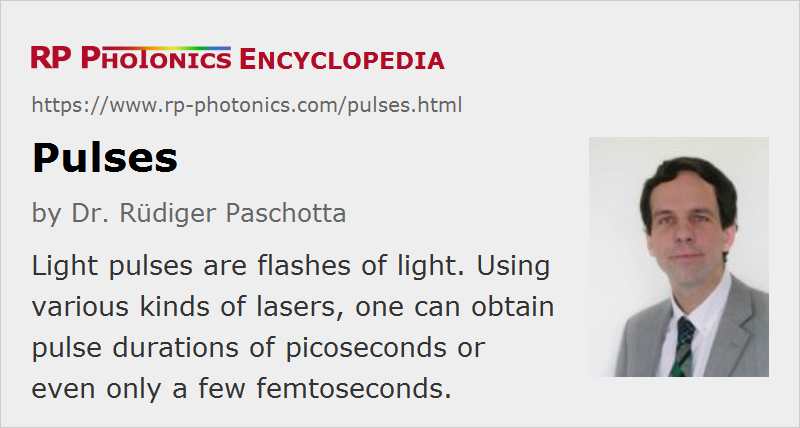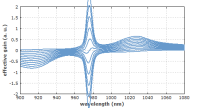Pulses
Definition: flashes of light
More specific terms: Gaussian pulses, sech2-shaped pulses, parabolic pulses, solitons, quasi-soliton pulses, bandwidth-limited pulses, chirped pulses, double pulses, ultrashort pulses, laser pulses
German: Pulse
How to cite the article; suggest additional literature
Author: Dr. Rüdiger Paschotta
Optical pulses are flashes of light, which are often generated with lasers (laser pulses) and delivered in the form of laser beams, i.e., with a high directional spatial shape. Due to the enormously high optical frequencies, optical pulses can be extremely short (ultrashort) when their optical bandwidth spans a significant fraction of the mean frequency. For example, a Gaussian pulse with a center frequency of 300 THz (corresponding to a wavelength of 1 μm) can easily have a bandwidth of 30 THz, and this already corresponds to a pulse duration of ≈ 15 fs if the pulse is transform-limited. The shortest optical pulses generated directly in lasers have durations around 5 fs, corresponding only to a few optical cycles (few-cycle pulses). Pulse compression techniques reach very few femtoseconds, and high harmonic generation even allows the generation of attosecond pulses. On the other hand, many commercially important laser sources (particularly Q-switched lasers) generate nanosecond pulses, which also have many applications.
Due to the short pulse durations and the potential for strong focusing, optical pulses can be used for generating extremely high optical intensities even with moderate pulse energies. For example, a 10-fs pulse with only 10 mJ energy has a peak power of the order of 1 TW = 1000 GW, corresponding to the combined power of roughly 1000 large nuclear power stations. This power may be focused to spots only a few micrometers in diameter. Therefore, amplified ultrashort pulses are very important for high-intensity physics, studying phenomena such as multi-photon ionization, high harmonic generation, or the generation of even shorter pulses with attosecond durations.
Depending on the required pulse duration, pulse energy, and pulse repetition rate, different methods of pulse generation, pulse compression and pulse characterization are used, overall covering extremely wide parameter regimes. See the corresponding articles for details.
Pulse propagation in media has many interesting aspects. The peak of a pulse in a transparent medium propagates with the group velocity, not the phase velocity. Dispersion can cause temporal broadening (or sometimes compression) of pulses. For high peak intensities, optical nonlinearities can strongly affect the pulse propagation; often they lead to pulse broadening, but strong nonlinear compression is also possible.
There are various methods for measuring the pulse duration achieved or for pulse characterization in other respects. Particularly for measuring the duration of ultrashort pulses, purely optical techniques are very important, since electronics are too slow for such purposes.
Questions and Comments from Users
Here you can submit questions and comments. As far as they get accepted by the author, they will appear above this paragraph together with the author’s answer. The author will decide on acceptance based on certain criteria. Essentially, the issue must be of sufficiently broad interest.
Please do not enter personal data here; we would otherwise delete it soon. (See also our privacy declaration.) If you wish to receive personal feedback or consultancy from the author, please contact him e.g. via e-mail.
By submitting the information, you give your consent to the potential publication of your inputs on our website according to our rules. (If you later retract your consent, we will delete those inputs.) As your inputs are first reviewed by the author, they may be published with some delay.
Bibliography
| [1] | R. Paschotta, Field Guide to Laser Pulse Generation, SPIE Press, Bellingham, WA (2007) |
See also: ultrashort pulses, double pulses, pulse duration, pulse energy, pulse repetition rate, carrier–envelope offset, spectral phase, pulse generation, pulse characterization, pulse propagation modeling, pulsed lasers, ultrafast lasers, mode-locked lasers, Q-switched lasers
and other articles in the category light pulses
 |






If you like this page, please share the link with your friends and colleagues, e.g. via social media:
These sharing buttons are implemented in a privacy-friendly way!